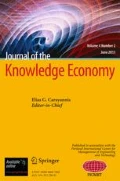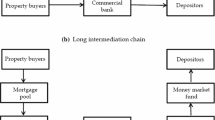Abstract
A layered financial structure is the key institutional feature of the financial subsystem of a knowledge economy. The concept was introduced by Irving Minsky and has been proven the empirical key in understanding bank panics, such as the global financial crisis of 2007–2008. However, even after such crisis, the operations of the shadow-banking layer of the structure continue to provide major financial perturbations—such as major trading losses in integrated banks. We develop a graphic model of a layered-financial system and explore how financial technology alters the processes in such structures, particularly in increasing financial instability. We use it to analyze the large trading loss by JP Morgan Chase in 2012.



Similar content being viewed by others
References
Angelides, P. (2011). Justice, Reform, and Rebuilding in the Wake of the Financial Crisis. 2oth Annual Hyman P. Minsky Conference on the State of the US and World Economies, New York City, 13–15 April 2011. A conference organized by the Levy Economics Institute of Bard College.
Bernanke, B. S. (2007). Regulation and financial innovation. 2007 Financial Markets Conference, Sea Island, Georgia, May 15. Federal Reserve Bank of Atlanta.
Betz, F., & Khalil, T. (2011). Technology and Financial Innovation, International Journal of Innovation and Technology Management, January 2011.
Buck, C. (1988). The Predators’ Ball: the inside story of Drexel Burnham and the rise of the junk bond raiders. Simon and Schuster (Penguin paperback, 1989).
Burrough, B., & Helyar, J. (1990). Barbarians at the Gate: The Fall of RJR Nabisco, Harper Collins.
Dash, E., & Craig, S. (2011). Big Paydays Return With Big Profits at Wall Street Banks, The New York Times, January 22, p. B4.
De La Merced, M. J. (2012). Weill Calls for Splitting Up Big Banks, New York Times, July 25.
Eavis, P., & Craig, S. (2012). The Bet That Blew Up for JPMorgan Chase, New York Times, May 11.
Fisher, I. (1933). The Debt-Deflation Theory of the Great Depression. Econometrica, October 1933.
Gandel, S. (2012). JPMorgan’s Dimon gets $23 million for 2011 and bragging rights, Fortune, April.
Jenkins, P. (2012). Scandals Dominate Bank Sector, Financial Times, December 29–30.
Kindleberger, C. (1978). Manias, Panics, and Crashes. (Reprinted in 2011, by Palgrave McMillan, with Robert Z. Aliber).
Lowenstein, R. (2010). Jamie Dimon: America’s Least-Hated Banker, New York Times, December 5.
McCulley, P. (2007). Comments Before the Money Marketeers Club, PIMCO (http://web.archive.org/web/20100206185224/http://www.pimco.com/LeftNav/Featured+Market+Commentary/FF/2009/Global+Central+Bank+Focus+April+2009+Money+Marketeers+Solitaire+McCulley.htm).
McCulley, P. (2007). “Teton Remarks”. http://web.archive.org/web/20091124124300/http://www.pimco.com/LeftNav/Featured+Market+Commentary/FF/2007/GCBF+August-+September+2007.htm (McCulley, 2007a).
Minsky, H. (1975). John Maynard Keynes. New York: Columbia University Press (reprinted in 2008 by McGraw-Hill).
Morgenson, G. (2012). At JPMorgan, the Ghost of Dinner Parties Pas. New York Times, May 12.
National Commission (2011). The Financial Crisis Inquiry Report. National Commission on the Causes of the Financial and Economic Crisis in the U.S. Government Printing Office.
Protess, B. (2012). Jamie Dimon Shows Some Love for Volcker Rule, New York Times, May 21.
Russell, K., & Pecanha, S. (2012). At JPMorgan Chase, a Complex Strategy That Backfired, New York Times, May 11.
Stone, A., & Brewster, M. (2002). King of Capital: Sandy Weill and the Making of Citigroup. New York: Wiley, 2002 ISBN 0-471-33015-9.
Stone, A., & Brewster, M. (2002). King of Capital: Sandy Weill and the Making of Citigroup. New York: Wiley, 2002 ISBN 0-471-33015-9.
Tett, G., & Davies, P. J. (2007). Out of the shadows: How banking’s secret system broke down. Financial Times, December 16.
Author information
Authors and Affiliations
Corresponding author
Rights and permissions
About this article
Cite this article
Betz, F. Modeling a Layered Financial Structure in a Knowledge Economy. J Knowl Econ 5, 841–862 (2014). https://doi.org/10.1007/s13132-013-0167-2
Received:
Accepted:
Published:
Issue Date:
DOI: https://doi.org/10.1007/s13132-013-0167-2




